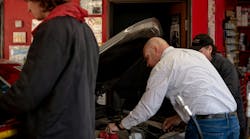Winter is coming. For car owners in most of the country, snow and ice present the worst possible conditions for operating a vehicle. That means, in addition to routine maintenance, you’re going to need to help prepare customers ahead of time for extreme weather.
“Don’t wait until the cold hits to ready vehicles,” said Herbert Steurer, passenger vehicle lubricants brand supervisor for ExxonMobil Fuels & Lubricants. “With a little foresight, you will [help them] save money, save fuel and even help the environment by prepping for the winter season.”
Battery Maintenance
Car batteries are often hit hardest by the cold weather, which severely impacts their cranking power. This is especially true in batteries over four years old. Before the winter weather sets in, make sure to advise customers to pack a set of good jumper cables in their vehicles. Alternately, emergency starts are possible with all-in-one power packs – a great portable investment to have on hand.Filters, Coolant and Hoses
As part of routine maintenance, check all filters — gas, oil and air — and any soft or leaking hoses for potential replacement. Additionally, make sure their heater and window defrosters are in good working order before they’ll actually need them. A vehicle’s coolant and thermostat should also be checked — experts call for coolant change every two years, though extended-life coolants can last about five.Tire Pressure
Icy roads can be made even worse without the proper tires. First, check the tread, and be sure to rotate or replace tires that are worn down or weathered. Also, make sure tires are inflated properly, not over-inflated or under-inflated. This is an easy fix that many neglect to handle on their own. Tires inflated at a low-pressure will always lead to quicker wear and decrease fuel efficiency in any weather condition. But, as winter is concerned, over-inflation reduces the proper traction in icy conditions.Lubrication
In winter weather, protecting the engine from damage during multiple cold startups is incredibly important. Make sure you choose a full-synthetic, multi-viscosity oil formulated for these extreme conditions that supports engine starts as low as -25 F to -30 F. Low-viscosity, full-synthetic oils speed startup and reduce wear by flowing quickly to critical engine parts. Additionally, the use of lower viscosity oils improves fuel economy.Vehicle Warmup
During cold starts, it’s not necessary to let the engine idle for an extended time. When starting, allow idling for a few seconds before putting the vehicle in gear to begin the proper oil flow and lubrication. Extended idles in modern vehicles only waste fuel and won’t actually warm up the drivetrain components. Simply advise customers to drive normally for a few miles after starting.It’s Nice to De-Ice
You don’t want your customers to wake up to an icy vehicle and nothing but a CD jewel case to save the day. Before winter hits, advise them to get some ice scrapers and de-icing gear. This is also the time to make sure their windshield wipers and front and rear defrosters are in good working order. A de-icer spray for frozen locks can also be a lifesaver, as well as spray-traction aids in the event of a stuck vehicle and a small snow shovel. Many hardware and home stores sell bags of sand to give vehicles extra trunk weight and traction, but can also be used on snow and ice for increased traction. And, as your mom says, don’t forget a warm coat, hat, gloves, boots and a blanket in case you get stuck in the cold.“Preventive care and mindfulness leading into the winter months can make a huge difference when storms actually hit,” Steurer said. “And, of course, you’re going to save money in the long run.”





